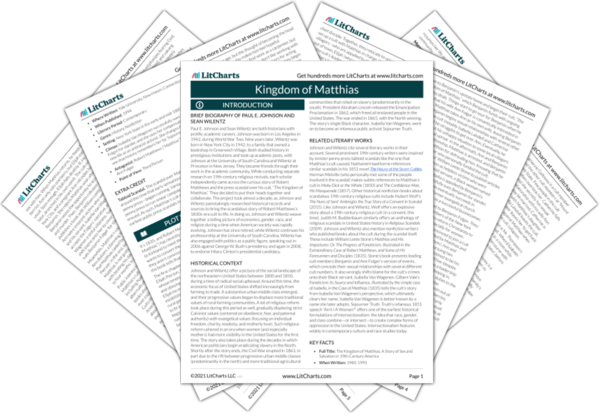Summary
Analysis
In 1835, Prophet Matthias, who has recently been released from prison (he was imprisoned for assaulting his daughter), travels alone to the Mormon settlement at Kirtland. He arrives to find a crude colony in which an unimpressive church is being constructed. Matthias introduces himself as a Jewish minister named Joshua to Joseph Smith, the prophet of the Mormon Church. The pair exchange their insights about God. Smith says that he’s translated God’s sacred records into the Book of Mormon. Meanwhile, Matthias rambles about his visions, in which God tells him that the United States is a failed kingdom that did not bring equality and freedom to all, and that the Mormons should flee.
Joseph Smith founded the Mormon church (Church of Jesus Christ of Latter-day Saints) in the 1820s–1830s, based on reported angelic visitations. Smith established the first Mormon headquarters in Kirtland, Ohio, in 1831. By opening the book with Matthias seeking out Smith, the book places Matthias in the same fringe religious category, outside the mainstream of American Christianity. Matthias’s disillusionment with the United States also suggests that he is struggling to adapt to a changing society: despite the industrial economic boom in the United States in the 1800s, Matthias feels that he and other religious people are marginalized.
Themes
Matthias successfully managed to convince others to believe in his visions before, including his (now deceased) follower Elijah Pierson and Pierson’s church group, but Smith isn’t convinced. Nonetheless, Smith lets Matthias preach to his Mormon group. Later that day, the congregation figures out that Matthias is a convicted fraud and murderer. Unfazed, Matthias tells the group that he’s a direct descendant of Jesus Christ. Smith decides that an evil spirit has invaded Matthias’s soul, and he tells Matthias to leave.
Matthias’s religious beliefs are decidedly unorthodox—especially his emphasis on personal visions and his belief that Jesus is his ancestor (neither of which would be supported by mainstream Christianity). Even Smith and his followers find Matthias’s ideas, and especially his past, suspect—showing that in an era that saw widespread religious experimentation in the U.S., Matthias is more radical than average.
Themes
In the early 1800s, shortly after the Civil War, the United States begins to emerge as a world power. Around this time, the emerging “Yankee middle class” begins driving American culture’s moral agenda. Such people, including revivalist preacher Charles Grandison Finney, spread “Finneyite” ideas celebrating reform and personal freedom. According to this view, any coercive behavior—including slavery and patriarchy—is wrong. This new moral agenda conflicts with many traditional ideals in the Southern states. It’s around this time that widespread occult, supernatural, and religious speculation takes hold among poor, uneducated Americans like Matthias and Smith.
The United States is clearly in a time of rapid evolution: industrialization, urban development, and a rising middle class begin to have more influence in society, marginalizing rural farming communities. At the same time, the Second Great Awakening—a movement marked by Protestant religious revivals and upheaval in traditional denominations—echoed these broader cultural changes by emphasizing individual choice and social transformation. The preaching of Charles Finney, which downplayed older Calvinist emphases on personal sin and the need for supernatural conversion, was one expression of Great Awakening religion. Matthias’s and Smith’s more marginal sectarianism is another stream of the Awakening—one sometimes favored by rural, less educated Americans who were struggling to adapt to sweeping cultural changes.
Themes
In contrast to the Finneyite moral agenda, Matthias and Smith’s rhetoric celebrates “fixed social relations and paternal power.” It’s hostile to Finneyite ideas like reforming people’s morals, celebrating everybody’s personal freedom, and growing wealth through trade. Both Matthias and Smith proclaim themselves as the dominant patriarchs of the world. They cling to “grim” Old Testament values of fatherly authority, respect for the family, and poor, rural living.
The authors contrast a “Finneyite” approach to religion with that of figures like Matthias and Smith, portraying the former as progressive and the latter as regressive. In particular, they suggest that Matthias and Smith wanted to maintain a patriarchal approach to religion (meaning that men hold primary authority) in contrast to a Finneyite approach that de-emphasized such authority. The authors also characterize this more familial, less urbanized ethos as backward and repressive.
Themes
Get the entire Kingdom of Matthias LitChart as a printable PDF.

In the 1830s, the press sensationalizes Matthias’s cult (the “Kingdom of Matthias”) for its preoccupation with murder and sexual crime. Yet, the story of Matthias’s cult also tells an interesting social story about American society. It exposes one way in which poor 19th-century Americans attempted to resist the social and religious dominance of emerging, affluent middle classes.
The book hints at the sensational aspects of the cult surrounding Matthias, which coming chapters will explore. However, the book’s broader focus is sociological—that is, the authors believe Matthias’s story reveals something about social transformation in 19th-century America, especially the resistance of those who felt left behind by the ascendant middle class.
Themes












